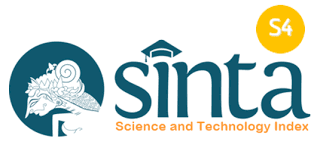Peningkatan Kapasitas Antioksidan Akibat Latihan Aerobik Intensitas Sedang
Abstract
Latihan aerobik intensitas sedang diindikasikan mampu meningkatkan kapasitas antioksidan dalam tubuh manusia, yang salah satunya ditandai dengan peningkatan SOD plasma. Penelitian ini bertujuan untuk mengkaji besarnya peningkatan kapasitas antioksidan akibat latihan aerobik intensitas sedang. Penelitian ini merupakan penelitian eksperimental semu dengan pendekatan kuantitatif dan rancangan one group pretest and posttest design. Populasi dalam penelitian ini adalah mahasiswa jurusan Pendidikan Kepelatihan Olahraga Univeristas Negeri Malang. Teknik sampling menggunakan purposive sampling, dengan jumlah sampel sebanyak 20 mahasiswa. Data dikumpulkan dengan mengukur aktivitas SOD plasma darah sebagai indikator kapasitas antioksidan. Pengukuran SOD dilakukan sebelum dan setelah perlakuan latihan aerobik intensitas sedang, dengan frekensi 3 kali perminggu, selama 8 minggu. Data kemudian dianalisis dengan uji-t berpasangan (α=0,05). Hasil penelitian didapatkanrata rata dan standar deviasi aktivitas SOD pretest 21,78±2,60 U/ml dan postest 32,03±1,42 U/ml, terdapat peningkatan rata-rata aktivitas SOD plasma sebesar 23,9% (p=0,023< 0,05). Simpulan penelitian ini terdapat peningkatan kapasitas antioksidan yang signifikan akibat latihan aerobik intensitas sedang
Downloads
References
Anggiane Putri, M. (2019). Peningkatan Antioksidan Endogen yang Dipicu Latihan Fisik. YARSI Medical Journal, 26(3). https://doi.org/10.33476/jky.v26i3.760
Azizbeigi, K., Azarbayjani, M. A., Peeri, M., Agha-alinejad, H., & Stannard, S. (2013). The effect of progressive resistance training on oxidative stress and antioxidant enzyme activity in erythrocytes in untrained men. International Journal of Sport Nutrition and Exercise Metabolism, 23(3). https://doi.org/10.1123/ijsnem.23.3.230
Azizbeigi, K., Stannard, S. R., Atashak, S., & Mosalman Haghighi, M. (2014). Antioxidant enzymes and oxidative stress adaptation to exercise training: Comparison of endurance, resistance, and concurrent training in untrained males. Journal of Exercise Science and Fitness, 12(1). https://doi.org/10.1016/j.jesf.2013.12.001
de Araujo, G. G., Papoti, M., dos Reis, I. G. M., de Mello, M. A. R., & Gobatto, C. A. (2016). Short and long term effects of high-intensity interval training on hormones, metabolites, antioxidant system, glycogen concentration, and aerobic performance adaptations in rats. Frontiers in Physiology, 7(OCT). https://doi.org/10.3389/fphys.2016.00505
de Sousa, C. V., Sales, M. M., Rosa, T. S., Lewis, J. E., de Andrade, R. V., & Simões, H. G. (2017). The Antioxidant Effect of Exercise: A Systematic Review and Meta-Analysis. In Sports Medicine (Vol. 47, Issue 2). https://doi.org/10.1007/s40279-016-0566-1
de Souza, R. F., de Moraes, S. R. A., Augusto, R. L., de Freitas Zanona, A., Matos, D., Aidar, F. J., & da Silveira Andrade-da-Costa, B. L. (2019). Endurance training on rodent brain antioxidant capacity: A meta-analysis. In Neuroscience Research (Vol. 145). https://doi.org/10.1016/j.neures.2018.09.002
Dunggio, A. R. S. (2021). Model latihan fisik jalan kaki dengan pemberian jus galoba terhadap komposisi lemak tubuh dan status antioksidan pada wanita usia >55 tahun. AcTion: Aceh Nutrition Journal, 6(1). https://doi.org/10.30867/action.v6i1.246
Erejuwa, O. O., Sulaiman, S. A., & Ab Wahab, M. S. (2012). Honey: A novel antioxidant. In Molecules (Vol. 17, Issue 4). https://doi.org/10.3390/molecules17044400
Escobar, M., Oliveira, M. W. S., Behr, G. A., Zanotto-Filho, A., Ilha, L., Cunha, G. D. S., de Oliveira, À. R., & Moreira, J. C. F. (2009). Oxidative stress in young football (soccer) players in intermittent high intensity exercise protocol. Journal of Exercise Physiology Online, 12(5).
Hottenrott, K., Ludyga, S., & Schulze, S. (2012). Effects of high intensity training and continuous endurance training on aerobic capacity and body composition in recreationally active runners. Journal of Sports Science and Medicine, 11(3).
Ismaeel, A., Holmes, M., Papoutsi, E., Panton, L., & Koutakis, P. (2019). Resistance training, antioxidant status, and antioxidant supplementation. International Journal of Sport Nutrition and Exercise Metabolism, 29(5). https://doi.org/10.1123/ijsnem.2018-0339
Katch, V. L., McArdle, W. D., & Katch, F. I. (2013). Essentials of exercise physiology: Fourth edition. In Essentials of Exercise Physiology: Fourth Edition.
Mayorga-Vega, D., Viciana, J., & Cocca, A. (2013). Effects of a circuit training program on muscular and cardiovascular endurance and their maintenance in schoolchildren. Journal of Human Kinetics, 37(1). https://doi.org/10.2478/hukin-2013-0036
Park, S.-Y., & Kwak, Y.-S. (2016). Impact of aerobic and anaerobic exercise training on oxidative stress and antioxidant defense in athletes. Journal of Exercise Rehabilitation, 12(2). https://doi.org/10.12965/jer.1632598.299
Poblete Aro, C. E., Russell Guzmán, J. A., Soto Muñoz, M. E., & Villegas González, B. E. (2015). Effects of high intensity interval training versus moderate intensity continuous training on the reduction of oxidative stress in type 2 diabetic adult patients: CAT. Medwave, 15(7). https://doi.org/10.5867/medwave.2015.07.6212
Poljsak, B. (2011). Strategies for reducing or preventing the generation of oxidative stress. In Oxidative Medicine and Cellular Longevity. https://doi.org/10.1155/2011/194586
Rahman, K. (2007). Studies on free radicals, antioxidants, and co-factors. In Clinical interventions in aging (Vol. 2, Issue 2).
Schöttker, B., Brenner, H., Jansen, E. H. J. M., Gardiner, J., Peasey, A., Kubínová, R., Pajak, A., Topor-Madry, R., Tamosiunas, A., Saum, K. U., Holleczek, B., Pikhart, H., & Bobak, M. (2015). Evidence for the free radical/oxidative stress theory of ageing from the CHANCES consortium: A meta-analysis of individual participant data. BMC Medicine, 13(1). https://doi.org/10.1186/s12916-015-0537-7
Sheikholeslami Vatani, D., & Ahmadi Kani Golzar, F. (2012). Changes in antioxidant status and cardiovascular risk factors of overweight young men after six weeks supplementation of whey protein isolate and resistance training. Appetite, 59(3). https://doi.org/10.1016/j.appet.2012.08.005
Vieira Junior, R. C., Santos Silva, C. M., de Araújo, M. B., Garcia, A., Voltarelli, V. A., dos Reis Filho, A. D., & Voltarelli, F. A. (2013). Aerobic swimming training increases the activity of antioxidant enzymes and the glycogen content in the skeletal muscle of rats. Revista Brasileira de Medicina Do Esporte, 19(3). https://doi.org/10.1590/S1517-86922013000300012
Wang, C. H., Wu, S. B., Wu, Y. T., & Wei, Y. H. (2013). Oxidative stress response elicited by mitochondrial dysfunction: Implication in the pathophysiology of aging. In Experimental Biology and Medicine (Vol. 238, Issue 5). https://doi.org/10.1177/1535370213493069
Zalukhu, M. L., Phyma, A. R., & Pinzon, R. T. (2016). Proses Menua, Stres Oksidatif, dan Peran Anti Oksidan. Cermin Dunia Kedokteran, 43(10), 733–736.
Copyright (c) 2022 Jurnal Patriot

This work is licensed under a Creative Commons Attribution-ShareAlike 4.0 International License.



_(700_x_400_mm)_(3)_.png)


_(700_x_400_mm)_1.png)



